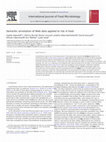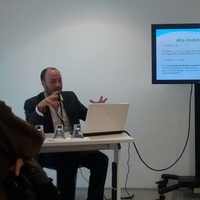Papers by Olivier Couvert

International Journal of Food Microbiology, 2005
The classical D-value of first order inactivation kinetic is not suitable for quantifying bacteri... more The classical D-value of first order inactivation kinetic is not suitable for quantifying bacterial heat resistance for non-log linear survival curves. One simple model derived from the Weibull cumulative function describes non-log linear kinetics of micro-organisms. The influences of environmental factors on Weibull model parameters, shape parameter bpQ and scale parameter bdQ, were studied. This paper points out structural correlation between these two parameters. The environmental heating and recovery conditions do not present clear and regular influence on the shape the parameter bpQ and could not be described by any model tried. Conversely, the scale parameter bdQ depends on heating temperature and heating and recovery medium pH. The models established to quantify these influences on the classical bDQ values could be applied to this parameter bdQ. The slight influence of the shape parameter p variation on the goodness of fit of these models can be neglected and the simplified Weibull model with a constant p-value for given microbial population can be applied for canning process calculations. D

Food Microbiology
A mechanistic model coupling O2 and CO2 mass transfer (namely diffusion and solubilisation in the... more A mechanistic model coupling O2 and CO2 mass transfer (namely diffusion and solubilisation in the food itself and permeation through the packaging material) to microbial growth models was developed aiming at predicting the shelf life of modified atmosphere packaging (MAP) systems. It was experimentally validated on a non-respiring food by investigating concomitantly the O2/CO2 partial pressure in packaging headspace and the growth of Listeria monocytogenes (average microbial count) within the food sample. A sensitivity analysis has revealed that the reliability of the prediction by this "super-parametrized" model (no less than 47 parameters were required for running one simulation) was strongly dependent on the accuracy of the microbial input parameters. Once validated, this model was used to decipher the role of O2/CO2 mass transfer on microbial growth and as a MAP design tool: an example of MAP dimensioning was provided in this paper as a proof of concept. Copyright © 20...

Food microbiology, 2015
The process of dried fermented sausages is recognized to be favourable to the reduction of the Sa... more The process of dried fermented sausages is recognized to be favourable to the reduction of the Salmonella population. The objective of this study was to develop a model describing the evolution of Salmonella during the fabrication process of dried sausages and to optimize the food formulation to prevent pathogen presence at the end of the process. An experimental design was set to investigate the effects of the fermentation and drying process for several formulations, taking into account the type of starter culture, the sodium chloride concentration, the dextrose and lactose concentration on the Salmonella Typhimurium strain behaviour. A growth-inactivation model based on the gamma concept was then developed to quantify Salmonella behaviour in dynamic process conditions of temperature, pH, lactic acid and water activity. This behaviour was characterized by a first growth step, followed by an inactivation step. The Salmonella fate was well described by the model in terms of populatio...

Applied and Environmental Microbiology, 2014
The apparent heat resistance of spores of Bacillus weihenstephanensis and Bacillus licheniformis ... more The apparent heat resistance of spores of Bacillus weihenstephanensis and Bacillus licheniformis was measured and expressed as the time to first decimal reduction (δ value) at a given recovery temperature and pH. Spores of B. weihenstephanensis were produced at 30°C and 12°C, and spores of B. licheniformis were produced at 45°C and 20°C. B. weihenstephanensis spores were then heat treated at 85°C, 90°C, and 95°C, and B. licheniformis spores were heat treated at 95°C, 100°C, and 105°C. Heat-treated spores were grown on nutrient agar at a range of temperatures (4°C to 40°C for B. weihenstephanensis and 15°C to 60°C for B. licheniformis) or a range of pHs (between pH 4.5 and pH 9.5 for both strains). The recovery temperature had a slight effect on the apparent heat resistance, except very near recovery boundaries. In contrast, a decrease in the recovery pH had a progressive impact on apparent heat resistance. A model describing the heat resistance and the ability to recover according to the sporulation temperature, temperature of treatment, and recovery temperature and pH was proposed. This model derived from secondary mathematical models for growth prediction. Previously published cardinal temperature and pH values were used as input parameters. The fitting of the model with apparent heat resistance data obtained for a wide range of spore treatment and recovery conditions was highly satisfactory.
Sciences des Aliments, 2006
ABSTRACT

Letters in Applied Microbiology, 2006
In this study, the influence of the incubation temperature on the D-values was described accordin... more In this study, the influence of the incubation temperature on the D-values was described according to a simple Bigelow-like model. Model parameters were estimated from different sets of data from the literature and from our own data. For different Bacillus species and heat-treatment conditions, the influence of the recovery temperature was quantified and the optimal recovery temperature was determined. The impacts of species, bacterial strains belonging to the same species, heat-treatment temperature and composition of recovery media on the model parameters were analysed. The optimum recovery temperatures differ greatly from one species to another; however, no difference appears clearly between strains belonging to the same species. D values were significantly affected by recovery temperature. This influence of recovery temperature was dependent on the species, and affected by the composition of recovery media but not by the heating temperature. The developed model could be useful for determining the optimal incubation temperature and quantifying the weight of the recovery temperature influence for safe security control in the canning industry.
Journal of Clinical Microbiology, 2010
Cytotoxic activity levels of culture filtrates and toxin distributions varied according to the ph... more Cytotoxic activity levels of culture filtrates and toxin distributions varied according to the phylogenetic group (I to VII) within the Bacillus cereus group, suggesting that these groups are of different clinical significance and are more suitable than species affiliations for determining food poisoning risk. A first-line, simple online tool (https://www.tools.symprevius.org/Bcereus/english.php) to assign strains to the different phylogenetic groups is presented.

International Journal of Food Microbiology, 2002
3 application of the Weibull frequency distribution model. 4 5 P. MAFART, O. COUVERT, S. GAILLARD... more 3 application of the Weibull frequency distribution model. 4 5 P. MAFART, O. COUVERT, S. GAILLARD and I. LEGUERINEL 6 7 ABSTRACT A simple and parsimonious model originated from the Weibull frequency 8 distribution was proposed to describe non linear survival curves of spores. This model 9 was suitable for downward concavity curves (Bacillus cereus and Bacillus pumilus) as 10 well as for upward concavity curves (Clostridium botulinum). It was shown that 11 traditional F-values calculated from this new model were no more additive, to such an 12 extend that a heat treatment should be better characterized by the obtained decade 13 reduction of spores. A modified Bigelow method was then proposed to assess this decade 14 reduction or to optimize the heat treatment for a target reduction ratio. 15 16 20 logarithm of the number of surviving microorganisms and the treatment time at a given 21 temperature is used to estimate the D-value (time of decimal reduction). However, in many 22 cases , the survival curve of heated microorganisms is not linear and present a downward 23 concavity (presence of a shoulder) or an upward concavity (presence of a tail). A number of 24 models describing non linear survival curves were proposed. Some of them are mechanistic or 25 42 Where N represents the number of surviving cells after a duration of heat treatment t, while 43 N 0 is the initial size of the alive population. For a given temperature, parameter distribution 44 are k and p. 45 Peleg and Cole (1998) wrote out this model in the following decimal logarithmic form: 65 and suspended in sterile distilled water and washed three times by centrifugation (10000xg for 66 15 min) (Bioblock Scientific, model Sigma 3K30). The pellet was then resuspended in 5 ml 67 distilled water and 5 ml ethanol. The obtained suspension was then kept at 4°C during 12 68 hours in order to eliminate vegetative non sporulated bacteria, and washed again three times 69 by centrifugation. 70 Lastly the final suspension (about 10 10 spores ml -1 ) was at last distributed in sterile Eppendorfs 71 microtubes and kept at 4°C.

International Journal of Food Microbiology, 2005
The classical D-value of first order inactivation kinetic is not suitable for quantifying bacteri... more The classical D-value of first order inactivation kinetic is not suitable for quantifying bacterial heat resistance for non-log linear survival curves. One simple model derived from the Weibull cumulative function describes non-log linear kinetics of micro-organisms. The influences of environmental factors on Weibull model parameters, shape parameter bpQ and scale parameter bdQ, were studied. This paper points out structural correlation between these two parameters. The environmental heating and recovery conditions do not present clear and regular influence on the shape the parameter bpQ and could not be described by any model tried. Conversely, the scale parameter bdQ depends on heating temperature and heating and recovery medium pH. The models established to quantify these influences on the classical bDQ values could be applied to this parameter bdQ. The slight influence of the shape parameter p variation on the goodness of fit of these models can be neglected and the simplified Weibull model with a constant p-value for given microbial population can be applied for canning process calculations. D

International Journal of Food Microbiology, 2008
Time temperature integrators or indicators (TTIs) are effective tools making the continuous monit... more Time temperature integrators or indicators (TTIs) are effective tools making the continuous monitoring of the time temperature history of chilled products possible throughout the cold chain. Their correct setting is of critical importance to ensure food quality. The objective of this study was to develop a model to facilitate accurate settings of the CRYOLOG biological TTI, TRACEO ® . Experimental designs were used to investigate and model the effects of the temperature, the TTI inoculum size, pH, and water activity on its response time. The modelling process went through several steps addressing growth, acidification and inhibition phenomena in dynamic conditions. The model showed satisfactory results and validations in industrial conditions gave clear evidence that such a model is a valuable tool, not only to predict accurate response times of TRACEO ® , but also to propose precise settings to manufacture the appropriate TTI to trace a particular food according to a given time temperature scenario.
International Journal of Food Microbiology, 1999
A simple overall model is proposed to describe the effect of both the pH of the heating menstruum... more A simple overall model is proposed to describe the effect of both the pH of the heating menstruum and the pH of the recovery medium on the apparent spore heat resistance of Bacillus cereus. Applied to foods making up both heating and recovery media, the model can be reduced to only two parameters. Its goodness of fit and its robustness enable it to be applied to the optimisation of heat treatments. However, further experiments should be undertaken to validate the model for other species and to determine the parameters related to reference species such as Clostridium botulinum.
International Journal of Food Microbiology, 2007
Environmental conditions of sporulation influence bacterial heat resistance. For different Bacill... more Environmental conditions of sporulation influence bacterial heat resistance. For different Bacillus species a linear Bigelow type relationship between the logarithm of D values determined at constant heating temperature and the temperature of sporulation was observed. The absence of interaction between sporulation and heating temperatures allows the combination of this new relationship with the classical Bigelow model. The parameters z T and z T spo of this global model were fitted to different sets of data regarding different Bacillus species: B. cereus, B. subtilis, B. licheniformis, B. coagulans and B. stearothermophilus.

International Journal of Food Microbiology, 2007
The influence of heating treatment temperature, pH of heating and recovery medium on the survival... more The influence of heating treatment temperature, pH of heating and recovery medium on the survival kinetics of Salmonella typhimurium ATCC 13311 is studied and quantified. From each non-log linear survival curve, Weibull model parameters were estimated. An average shape parameter value of 1.67 was found, which is characteristic of downward concavity curves and is in agreement with values estimated from other S. typhimurium strains. Bigelow type models quantifying the heating temperature, heating and recovery medium pH influences are fitted on scale parameter δ data (time of first decimal reduction), which reflects the bacterial heat resistance. The estimate of z T (4.64°C) is in the range of values given in the literature for this species. The influence of pH of the heating medium on the scale parameter (z pH : 8.25) is lower than that of the recovery pH medium influence (z′ pH : 3.65).

International Journal of Food Microbiology, 2008
A preliminary step to risk in food assessment is the gathering of experimental data. In the frame... more A preliminary step to risk in food assessment is the gathering of experimental data. In the framework of the Sym'Previus project (), a complete data integration system has been designed, grouping data provided by industrial partners and data extracted from papers published in the main scientific journals of the domain. Those data have been classified by means of a predefined vocabulary, called ontology. Our aim is to complement the database with data extracted from the Web. In the framework of the WebContent project (www.webcontent.fr), we have designed a semi-automatic acquisition tool, called @WEB, which retrieves scientific documents from the Web. During the @WEB process, data tables are extracted from the documents and then annotated with the ontology. We focus on the data tables as they contain, in general, a synthesis of data published in the documents. In this paper, we explain how the columns of the data tables are automatically annotated with data types of the ontology and how the relations represented by the table are recognised. We also give the results of our experimentation to assess the quality of such an annotation.
International Journal of Food Microbiology, 2005
Several factorial models extending the famous Bigelow model to describe the influence of the heat... more Several factorial models extending the famous Bigelow model to describe the influence of the heating and recovery pH and a w conditions on bacterial heat resistance have been developed. These models can be associated in an overall multifactorial model describing the influences of heating and recovery conditions on D values. For Bacillus cereus strain ADQP 407 the model parameters characterising the environmental factor influences (pH, Temperature, a w ) were evaluated. Determination of bacterial heat resistance in cream chocolate have been realised to validate these parameter values and to evaluate the level of the influence of food texture or different compounds not taken account of in the model. D

International Journal of Food Microbiology, 2000
Conventional heat resistance data , D values, were previously established by other workers at opt... more Conventional heat resistance data , D values, were previously established by other workers at optimal condition for spores outgrowth. However, in canned food conditions of outgrowth are generally suboptimal in term of pH, salt concentration, water activity. Counts of survival spores after heat treatment are greatly influenced by the characteristics of the recovery medium. The selectivity of incubation conditions is enhanced by the injury of cells at sub-optimum recovery conditions. Both a decrease of number of viable cells being able to producing colonies and a decrease of the decimal reduction time is observed. The combined effects of pH and NaCl level of the recovery medium for the D value and Z pH value were studied. Spores of Bacillus cereus were heated at 95°C in phospho-citric buffer media at pH7. Cells were recovered at 25°C in nutritive agar with pH ranging from 5 to 7 and 1% to 4% NaCl concentration. For each condition D' values ( decimal reduction time associated with the recovery media characteristics) were determined. The results show a main influence of the recovery pH on the D' values. This effect is characterised by the z' pH values, distance of recovery medium pH from optimum recovery pH* medium (6.7) which leads to ten fold reduction time of D-value. The increase of the salt concentration leads to a slight decrease of D' value. However z' pH values are not significantly affected by the salt concentration. A simple three parameter model describing the effects of pH and NaCl concentration of the recovery medium upon the heat resistance of spores is proposed The interaction between pH and salt concentration is sufficiently low to be neglected by the model.









Uploads
Papers by Olivier Couvert